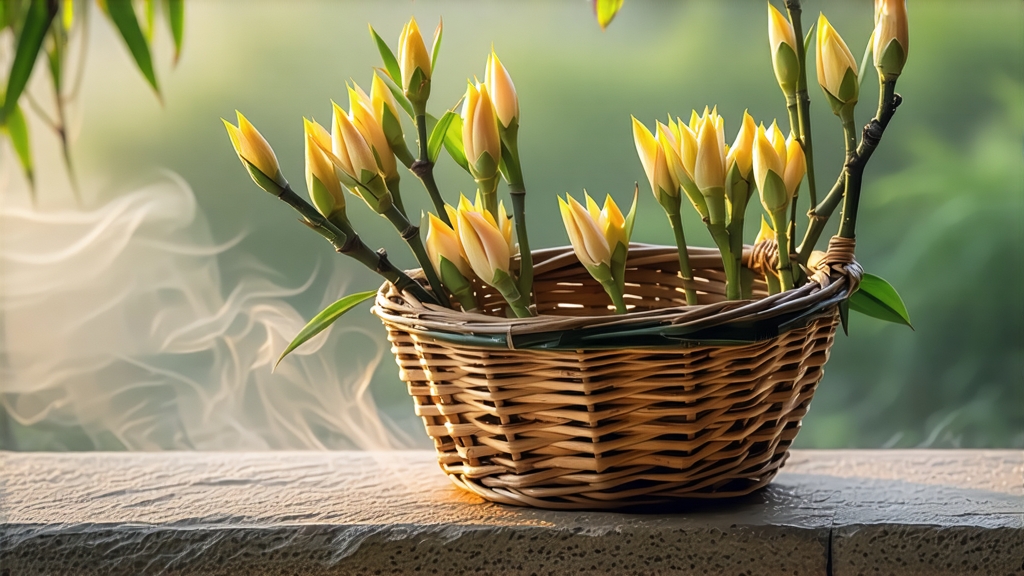
Tucked high on Mengding Mountain, where Sichuan’s perpetual cloud veil traps the fragrance of evergreen forests and Buddhist temple incense, Mengding Huangya has been quietly perfecting its golden character for twelve centuries. International drinkers who think they know Chinese tea often stop at Dragon Well or Da Hong Pao; yet the tiny, down-curled buds that local monks once called “immortal shoots” carry a flavor so suave and a history so regal that encountering it feels like stumbling upon a lost chapter of Chinese civilization. This article invites you to open that chapter, tracing the bud from Tang-dynasty tribute to twenty-first-century glass, and to master the gentle rituals that coax its hidden nectar into the cup.
-
Historical panorama
Mengding Mountain rises 1 450 m above the Chengdu plain, a granite spine whose eastern cliffs catch the first light of the Sichuan sunrise. In 724 CE, during the reign of Emperor Xuanzong, county gazettes record that 22-year-old monk Wu Lizhen planted seven tea bushes on the summit, believing the spot to be the mythical “Platform of Rain and Dew.” The tea was presented to court, and the Tang emperor—an ardent tea lover—declared it “the best under heaven,” a title later echoed by every subsequent dynasty. Song poet Wen Tong wrote that one sip “cleanses the marrow,” while the Ming imperial pharmacopoeia listed it as a cure for “heat and drunkenness.” By the Qing, the 12 original bushes had become state property; picking their flush was punishable by law unless you carried a golden tablet issued by the governor. Thus the tea entered legend as “Huangya,” the yellow bud reserved for the Son of Heaven. -
Terroir and cultivar
Mengding’s slopes enjoy 2 000 mm of mist-diluted rainfall annually, 200 fog-bound days, and a diurnal swing of 10 °C that slows photosynthesis, stacking amino acids—especially L-theanine—in every bud. The soil is a crumbly, slightly acidic purple sandstone rich in selenium and zinc, minerals that later translate into a tingling minerality on the tongue. Growers rely on two local clonal selections:- Mengding #9, a compact bush whose buds show ivory pubescence and a natural low-polyphenol profile that eases the yellowing process.
- Mengding #23, slightly larger, with higher carotenoids that deepen the golden liquor.
Both are plucked according to the “three centimeters rule”: only the unopened spear, no leaf unfurled, picked when the morning dew ball at its base is exactly 3 mm—small enough to evaporate within the basket ride down the mountain.
-
Crafting the yellow bud
Unlike green tea’s quick kill-green, Mengding Huangya undergoes “sealed yellowing,” a slow oxidation-fermentation hybrid that can last 72 hours. The choreography unfolds in five acts:
a. Kill-green at 160 °C on a Mengding cast-iron wok, 4 minutes, hand-tossed 240 times to deactivate 85 % of polyphenol oxidase while leaving 15 % alive for later transformation.
b. Initial roll under 2 kg pressure for 8 minutes, just enough to bruise the bud’s cuticle and release bound terpenes.
c. First drying at 90 °C to 55 % moisture; the buds shrink into tiny fishhooks.
d. The critical “men huang” (sealed yellowing): buds are piled 5 cm deep inside bamboo steamers lined with wet calico, then slid into a pine-wood cabinet maintained at 32 °C and 78 % humidity. Over three nights the residual enzymes oxidize chlorophyll into pheophytin, turning the leaf jade-green to old-gold; proteins fragment into free amino acids, stacking umami; flavonols condense, softening astringency. A master periodically inserts a long bamboo probe, sniffing the pile for the scent of fresh corn milk—when that note peaks, the yellowing stops.
e. Final low-temperature bake at 70 °C to 6 % moisture, followed by a curious “shoulder-kneading”: two craftsmen press the warm buds under their forearms, imparting a micro-curve that resembles an